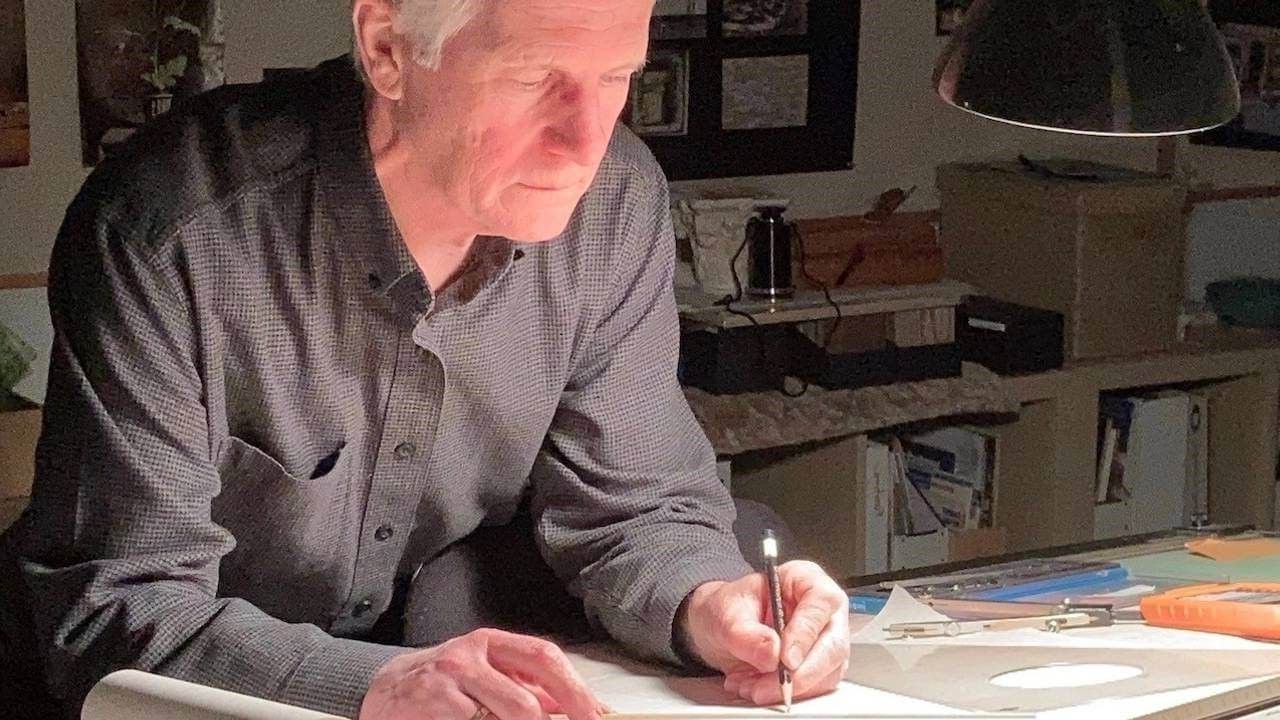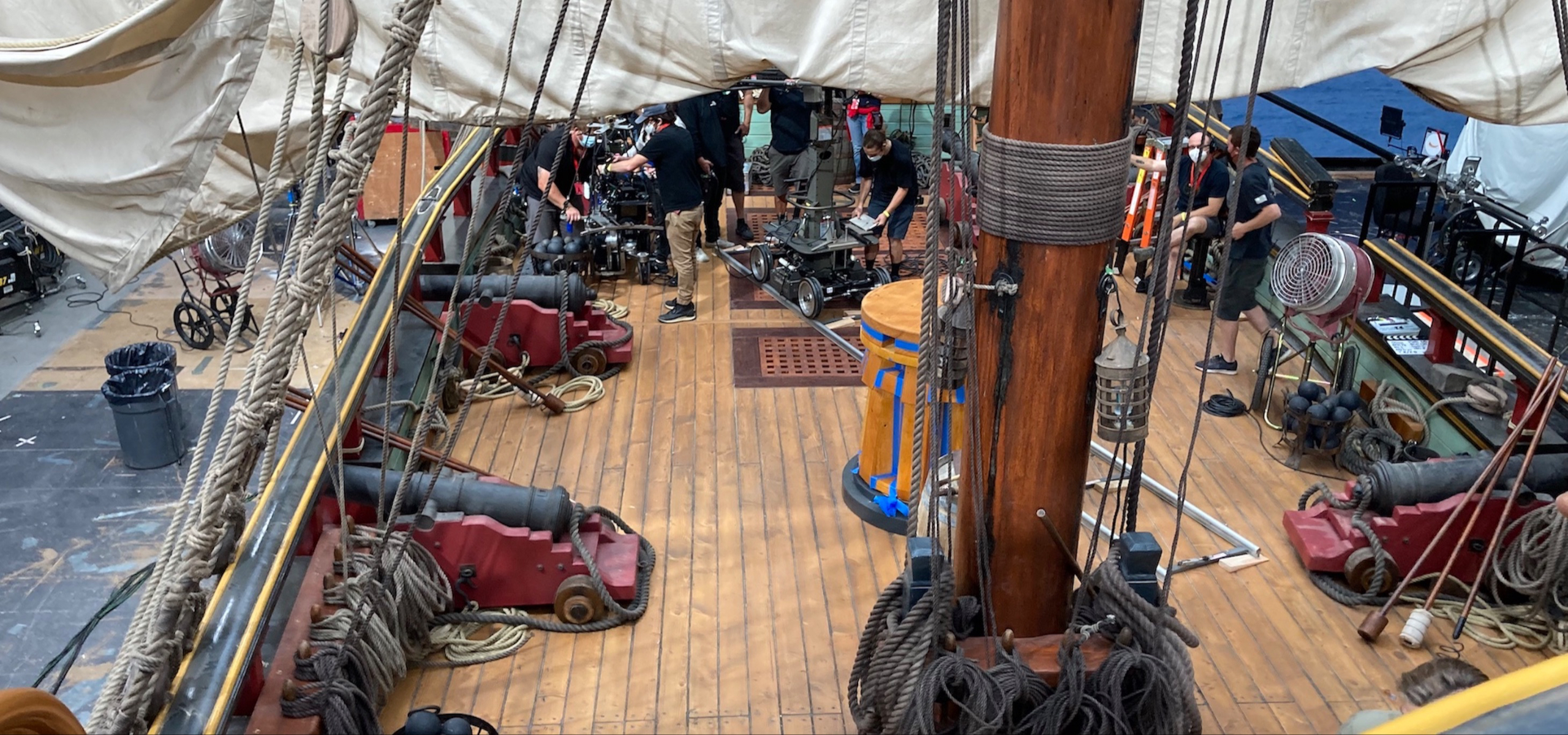Learn How To Design Film Sets
This intensive course covers the basics of motion picture and television set design. Upon completion, you will have an interview-ready, film industry-standard set of drawings to use when applying for a position in the Art Department.
No previous film school education is required.

Why I Designed This Course
I've enjoyed a long and successful career as a filmmaker and Set Designer, and now I want to mentor the next generation of film designers.
Early in my career, I learned these skills alongside seasoned Set Designers and Art Directors, who were my mentors. It was the established way of learning the unwritten skills that have been developed by generations of film designers.
That system of training new designers has evaporated with nothing to replace it until now. I have been teaching this same material to my peers in the Art Director's Guild and am now making it available to those outside the industry as well.
I want you to succeed.
The Result
Upon completion of the course you will have a portfolio of professionally vetted drawings to use in job interviews. In addition, you will learn the ground-level skills needed to work efficiently and effectively, not only as a Set Designer but also as an Art Director and a Production Designer.
Enroll in the courseHear from Peers in the Industry
"Randall is the most qualified and talented set designer I have ever had the pleasure to know and work with.
He not only has knowledge, talent, and craftsmanship as a set designer, but his experiences as a filmmaker and director give him unique insight into the whole design process."
_
Richard Hankins - Production Designer
Emmy Award Winner -
NYPD Blue
Private Practice
"If you want to understand Set Design, you could do no better than to study with Randall.
His knowledge is extensive and he is one of the most technically all-around talented designers I have ever worked with. He has all the imagination anyone would need to augment their experience.”
_
Jeannine Oppewall - Production Designer
Academy Award Nominee:
Best Art Direction- The Good Shephard
Best Art Direction- Seabiscuit
Best Art Direction- Pleasantville
Best Art Direction- L.A. Confidential
What You'll Learn In This Course
This intensive course covers the basics of set design for film and television.

Set Design & Construction
- Survey locations and create accurate as-built drawings.
- Create construction drawings; plans & elevations, scale detail drawings, FSD’s (full size details).
- Understand film set construction.
- Work on a sound stage.
- Shoot on studio backlots and locations.
- Create working drawings of period architecture, fantasy and futuristic/science fiction designs.
- Create working drawings of organic elements; topographic maps and terrain creation.
- Create working drawings for special effects shots, Director Plans, stage plans, and location layouts.
- Create dimensional study models of paper and wood.
Designing For The Camera & Visual Effects
- Understand cameras and lenses, aspect ratios, and lens types.
- Understand focal length and depth of field.
- Understand how to use camera angle templates.
- Learn how to scale from photographs using digital calipers.

Script Analysis & Breakdown
- Break down a script to determine the number of sets needed.
- Determine how many drawings are required for each set.
- Work from storyboards.
- Understand the set requirements of other departments; Camera, Lighting, and Visual Effects.
Requirements To Take The Course
No previous architectural or film education is required. Creatives from many different mediums have found success in the Art Department, from painters and illustrators to architects, interior designers, graphic designers, theater designers and beyond.
You don't need a degree to succeed but you do need curiosity and skills.
Drafting
- If you choose to create a portfolio of construction drawings, drafting ability is essential and no drafting instruction is included in this course.
- Completing a portfolio is not mandatory and is completely up to you.
- Whether you plan to create construction drawings as a set designer or move into a management position as Art Director or design the entire film as Production Designer, you must be able to communicate with a common language and that includes working drawings and construction documents. You will learn how to read and interpret a complicated set of working set drawings and construction documents. It's essential.
- Both hand drafting and digital drafting in the software of your choice are acceptable. You are free to use any CAD software you prefer. The film industry does not mandate the use of one CAD software over another.
- 3D modeling won’t be required for any of the class projects but feel free to work that way if that is a part of your usual design process.

Meet your Instructor
Randall Wilkins
- Over 30 years of experience in the film and television industry in Hollywood
- Credits span more than 80 film and television titles including Thor: Love and Thunder, Spider-Man: Homecoming, Catch Me If You Can
- Teaches classes in design at the Art Directors Guild in Los Angeles, at UCLA (University of California, Los Angeles)
- Guest lectures at schools internationally
I developed these courses to provide those interested in film design, a fundamental and foundational knowledge of designing and constructing the environments created for film and television in all its forms and genre, digital, built, futuristic or period correct.
Hear What Past Students Say About The Program
Patricia Witt
"The Set Design Foundations Series was an invaluable part of my Art Department education. It answered my questions about working full-time as a Set Designer and making a career in the entertainment industry. I learned so much about the tools, practices, and technical skills necessary for a successful start in film and TV. I thoroughly enjoyed this course and would recommend it to anyone looking to further their design skills.
Olesya Golub
"When I started the 10-Week Set Design Foundations Series class, I was hoping to learn about the drawings that a Set Designer needs to produce, but I learned much more. This course covered everything: drawings, how to do a site survey, what the set designer's responsibilities are, and their position in the Art Department. My favorite part was learning about what not to do as a set designer. Learning from others' mistakes made me feel more confident in my work process. I started a Set Design job shortly after finishing the class. The class helped me do my first job with confidence. This class is a perfect start for anyone who is beginning a career in Set Design."
Garrett Brown
"This is an amazing course taught by an industry pro. Randall is an excellent, kind, and patient teacher who somehow manages to cover everything from the construction of a single flat to measuring a cathedral in Florence from just photos. I cannot speak highly enough about this class. Anyone who is serious about a career in set design should be required to take this course.
Film Design Foundations
Course Syllabus
Units are released in one-week increments
Unit #1 - The Basics
- The structure of an Art Department.
- Standard drafting conventions and symbols for construction drawings.
- Set construction methods and techniques for stage sets.
Unit #2 - Cameras and Optics
- Cameras & Lenses, understanding aspect ratios, different lens types, Understanding focal length and depth of field.
- Using camera angle templates.
- Scaling from photographs.
Unit #3 - Analyzing the Script/Reference Materials
- Breaking down a script to determine the number of sets needed.
- Determine how many construction and detail drawings are required for each set.
- Working from storyboards.
- Finding and using references.
Unit #4 - Drawings
- Standard sheet sizes, layouts, and variations.
- Door & Window Schedules.
- Furniture/Ceiling/Deck Plans.
- Spotting Plans - determining the space limitations of a sound stage.
- Creating Director's Plans.
- Creating the 1/4" drawing, step-by-step.
- Drawing construction Details
- Creating cut files for CNC operations
Unit #5 - Door & Window Details
Door Details
- Types of doors and their construction.
- Door hardware.
- Creating the door details in 3/4" and full-size.
Window Details
- Types of windows and their construction.
- Window hardware.
- Creating the window details in 3/4" and full-size.
Unit #6 - Stairways
Stairs
- Types of stairs
- Typical stair construction methods.
- Creating the stair details for the set.
Unit #7 - Moulding and Staff Elements
Moulding
- Understanding and using the Classical Orders of architecture.
- Using moulding catalogs.
- Understanding and using the traditional proportional systems for moulding.
Staff
- Using staff in a set.
- How different types of staff pieces are created.
- Brick and texture skins-advantages, drawbacks, and challenges.
Unit #8 - Backings, Special Effects & Visual Effects
Painted and Photo Backings
- Types of backings and their use.
- Considerations when choosing a backing.
- Designing and creating a custom backing.
Special Effects Considerations
- Replicating natural elements -Fire/Water/Wind.
- Understanding the legal requirements for SFX work on a sound stage.
- Problems with practical fireplaces and live fire effects on a sound stage.
Visual Effects Considerations
- Green & Blue Screen work.
- LED Volumes.
Unit #9 - Backlots & Locations Surveys
- Shooting on backlots.
- Shooting on location.
- Scouting and surveying locations - scout preparation work.
- Assembling your survey tool kit.
Unit #10 - Physical Models
- Types of physical models
- Building a model for study purposes.
- Determining the right model scale.
- Assembling the materials.
- Various construction techniques for foamcore models.
Your Investment

Guarantee
Because of the special nature of the class and proprietary materials, refunds will only be offered within 14 days of course registration. Please be sure this class is for you before you commit to it. If you have any reservations, schedule a free discovery call with Randall to discuss whether or not this course fits your needs.
